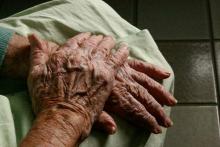HOLLYWOOD, FLA. – As more patients seek facial rejuvenation, they find themselves concerned with the mismatch between their refreshed facial appearance and the weathered, aged appearance of their hands. As more resurfacing treatments and fillers are being used beyond the face, options for hand rejuvenation expand.
Dr. Rania Agha, a dermatologist in private practice in Oakbrook Terrace, Ill., discussed a comprehensive approach to hand rejuvenation that addresses photoaging, vein prominence, and atrophy.
Sun exposure is the largest extrinsic factor that affects the appearance of hands. Resultant changes can include actinic keratosis, seborrheic keratosis, dermatoheliosis, and solar lentigines.
Intrinsic factors that contribute to hand aging include loss of collagen and fatty tissue, resulting in epidermal and dermal atrophy and loss of elasticity. Reduced hydration follows as well. Though hyaluronic acid is less than 1% of dermal dry weight, the loss of glycosaminoglycan-proteoglycan complexes means dermal tissue is much less effective at binding and retaining water, said Dr. Agha.
The consequences are wrinkles and prominence of bones and tendons, large intermetacarpal space, and prominent reticular veins. For many of her patients, “there will be a discordance of the face and the hands,” Dr. Agha nnoted.
Grading scales are available to evaluate hand aging, better to compare apparent hand age before and after treatment. The Merz Hand Grading Scale is used commonly and ranges from 0-4, with increasing scores for more wrinkles, bone and tendon prominence, and photodamage.
Where protuberant veins are a concern, sclerotherapy of the veins on the dorsum of the hand will reduce their prominence. Sclerotherapy options for the hand, where typical vessel size ranges from 1mm to 6 mm, are 0.5% sodium tetradecyl sulfate or polidocanol 1.5% or 3%. Post-sclerotherapy compression is recommended. An option of foam sclerotherapy, mixing the sclerosing agent with carbon dioxide or room air, can have greater efficacy because it prolongs contact between the sclerosant and the vein wall, but it theoretically carries some of the systemic risks associated with air emboli.
Adverse events from sclerotherapy can include telangiectatic matting, or microscopic revascularization; Dr. Agha said the reported incidence neared 15% in one study. Some pain, edema, and ecchymosis may occur; rare radial nerve neuropraxia has been reported. Other rare complications can include ulceration and hyperpigmentation.
Many energy-based, mechanical, and chemical rejuvenation techniques that are used on the face can also be used on the hands, though intensity or duration of treatment has to be modulated in some cases.
Superficial chemical peels only penetrate the epidermis; examples include 70% glycolic acid, salicylic acid, 50% resorcinol, Jessner’s solution, and trichloroacetic acid 10%-20%. Trichloroacetic acid at 30% or greater is an example of a medium-depth peel that extends to the papillary dermis. Deep peels that extend to the midreticular dermis, such as phenol, are not for use on the hands.
Even with light to medium peels, though, caution should be used. Reported complications can include maceration, desquamation, and delayed healing; also, practitioners should take care not to create a line of demarcation between the hand and forearm. “Be conservative and perform these gradually and serially over several weeks,” said Dr. Agha.
A wide range of laser and light therapies can be useful. Q-switched lasers are useful for solar lentigines and other photodamage; intense pulsed light, photodynamic therapy, Nd:YAG lasers, fractionated lasers, and the 2940 erbium:YAG laser are all options, depending on patient preference and what options are available.
“With light therapy, start at lower fluences,” said Dr. Agha. “Limit the number of passes, and the density, if you’re using a fractionated laser.” Complications can include erythema, hypo- or hyper-pigmentation, scarring, textural changes, crusting, and prolonged bleeding. Prompt local wound care can help mitigate long-term effects if any complications are seen post-treatment.
“Strict sun protection, whether with physical block or sunscreen, is a must after hand resurfacing,” whether the procedures are chemical or energy-based, said Dr. Agha.
Another option for hand rejuvenation is to use dermal fillers to plump the dorsum of the hand and obscure some of the exposed hand anatomy. Autologous fat can be used, but more demand is being seen for calcium hydroxylapatite microsphere (Radiesse) fillers, said Dr. Agha. “It is highly biocompatible; therefore, allergic reactions are extremely rare,” she said.
Calcium hydroxylapatite was approved by the Food and Drug Administration for hand rejuvenation in 2015. The particle size of 25-50 micrometers stimulates collagen formation and fibrosis when injected, and the product’s effects can last up to 18 months. In clinical trials, the product produced significant improvement in hand appearance without serious side effects in followup through 1 year.


